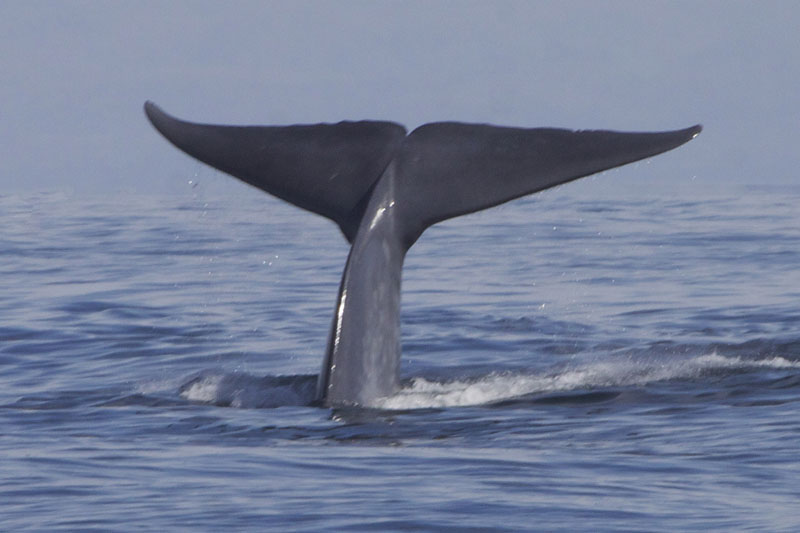
The largest animals that has ever lived!
Blue whales are the largest animals ever to have lived on Earth. Everything about them is on an epic scale. Yet for such large animals they are amazingly fast swimmers using their beautifully streamlined bodies to great effect. To give you some idea of their great size they are almost at long as the Space Shuttle! Their tongues alone can weigh as much as an elephant and their hearts, as much as a car.

Common Name: Antarctic Blue Whale
Other Names: The ‘true’ Blue Whale, The Sulfur-bottom whale
Scientific Name: Balaenoptera musculus intermedia
Conservation Status: Endangered
Length: New-born calf 6 to 7 metres, Adults 30+ metres.
Weight: Birth weight is about 2 to 3 tonnes. Adults 200 tonnes.
Gestation: 10–11 months
Weaning Age: 8 months and 16 metres in length
Calving Interval: 2 to 3 years
Sexual Maturity Age: Females 10 years old and at 23-24 metres in length
Males 10 years and 22 metres in length
Physical Maturity Age:
Lifespan: 80+ years
Mating Season: June to July
Calving Season: April to May
Cruising Speed: 20 kilometres per hour cruising and up to 35 kilometres per hour for short bursts
Protected Since: 1967

Common Name: Pygmy Blue Whale
Other Names:
Scientific Name: Balaenoptera musculus brevicauda
Conservation Status: Endangered
Length: New-born calf 6 to 7 metres, Adults up to 24 metres
Weight: Birth weight is about 1 to 2 tonnes. Adults 150 tonnes
Gestation: 10–11 months
Weaning Age: 8 months
Calving Interval: 2 to 3 years
Sexual Maturity Age: Females 10 years old and 21 metres in length
Males 10 years and 18 metres in length
Physical Maturity Age:
Lifespan: 80+ years
Mating Season: June to July
Calving Season: April to May
Cruising Speed: 20 kilometres per hour cruising and up to 35 kilometres per hour for short bursts
Protected Since: 1967

Field Identification
– Size – HUGE!
– Very tall blow up to ten metres in height.
– Light to dark grey in colour with distinctive mottled flank patterns.
– Broad flat U shaped head with prominent splash guard in front of the blow holes.
– Small dorsal fin well back.
– Can lift their tail clear of the water when diving unlike Fin Whales.- Usually alone or in pairs.
Note: Determining which Blue Whale subspecies (Antarctic/Pygmy) it is in the field can be difficult.
Blue Whale Amazing Facts
Some amazing things about blue whales:
– For a humongously large animal, they can move extremely fast.
-For a humungously large animal, they can quietly disappear without a trace.
– When they are seen through water, their grey skin appears a luminous blue.
– When they gulp their food (krill) mixed with seawater, their throat balloons out to hold up to 100 tonnes of water and from the air they look like an enormous ‘blue tadpole’.
– Somehow they can find small scattered patches of krill in water so murky they can’t see their own body length ahead.
– They can accurately navigate across thousands of kilometres of ocean during migration.
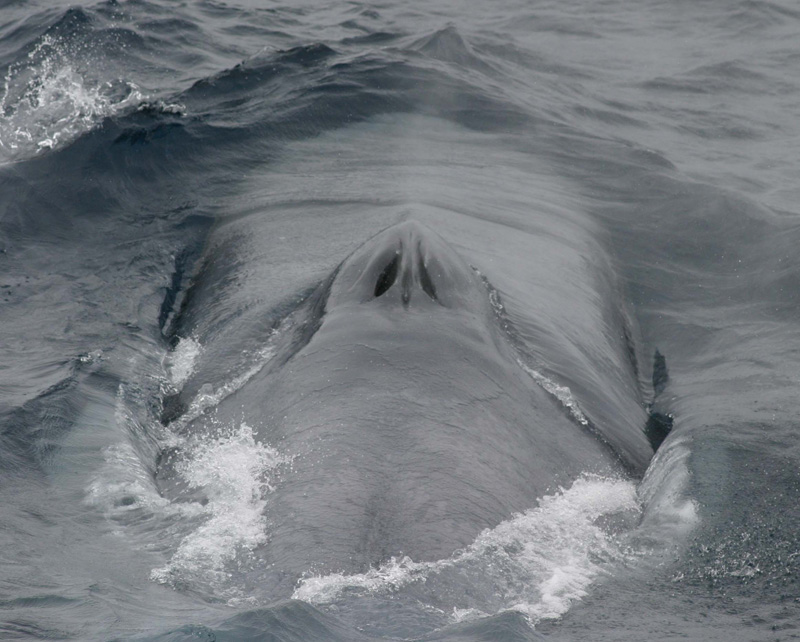
Taxonomy
The Blue Whales are the largest animals to have ever lived on Earth.
Their genus name, Balaenoptera, means winged whale and the species name, musculus, could mean “muscle”. Musculus may also be a diminutive form of “mouse” as a possible pun by Carl Linnaeus who named the species in Systema Naturae.
Blue Whales are are rorquals group of whales in reference to their throat grooves which extend from their chins to their umbilicus. The word rorqual comes from the Norwegian word rørhval. Other members of the rorquals are Fin Whale, Sei Whale, Bryde’s Whale, Minke Whales, Omura’s Whale and Humpback Whale. DNA studies suggest that Blue Whales are most closely related to Sei Whales with Grey Whales as a sister group.
The earliest discovered Blue Whale skull was found in southern Italy and dating from the Early Pleistocene, roughly 1.5–1.25 million years ago. The Australian Pygmy Blue Whale is believed to have diverged during the Last Glacial Maximum (over 33, 000 years ago).
Subspecies – The Society for Marine Mammalogy’s Committee on Taxonomy recognises four subspecies of Blue Whale.
– B. m. musculus
– B. m. intermedia
– B. m. brevicauda
– B. m. indica
These subspecies have been further divided into nine management groups.
Northern subspecies (B. m. musculus) – Eastern North Pacific
Northern subspecies (B. m. musculus) – Central and Western North Pacific
Northern subspecies (B. m. musculus) – North Atlantic
Antarctic subspecies (B. m. intermedia)
Pygmy subspecies (B. m. brevicauda) – Madagascar
Pygmy subspecies (B. m. brevicauda) – Western Australia/Indonesia
Pygmy subspecies (B. m. brevicauda) – Eastern Australia/New Zealand
Northern Indian Ocean subspecies (B. m. indica)
Chilean subspecies (B. m. unnamed subsp.)
In the waters of Oceania there are two subspecies the Antarctic Blue Whale (B. m. intermedia) and the Pygmy Blue Whale (B. m. brevicauda). Studies of the Blue Whales calls suggest that there is only one Antarctic subspecies in the Southern Ocean and two Pygmy Blue Whale subspecies the Western Australia/Indonesia population and the Eastern Australia/New Zealand population. These two populations are thought to be morphologically similar and not genetically separated. It is also thought that the New Zealand population is very genetically isolated. An acoustic boundary between the Western Australia/Indonesia population and the Eastern Australia/New Zealand populations has been identified as the junction of the Indian and Pacific Oceans.
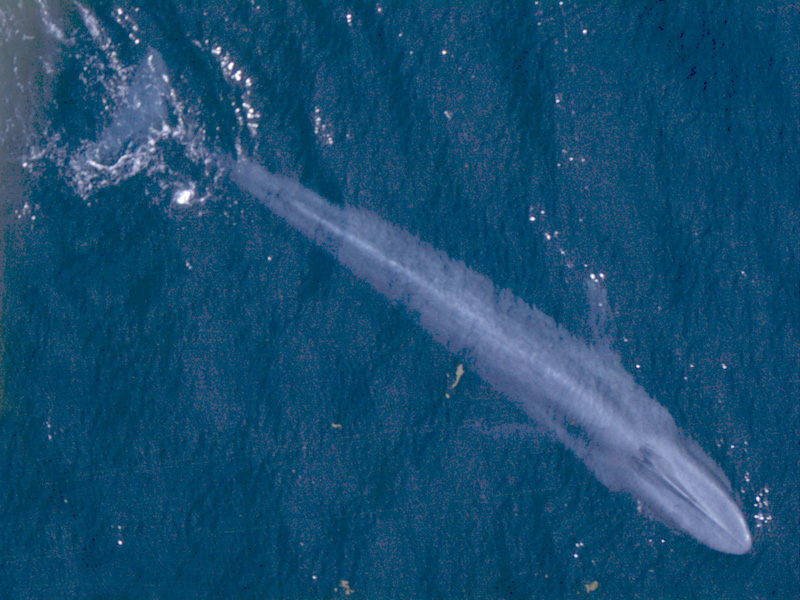
Description
Of all the whale species Blue Whales are perhaps the easiest to identify. Their giant size and striking pale blue colour makes it very difficult to confuse them with any other species. Like Fin whales they are amazingly agile and fast for such large animals which has led some people to refer to them at the Greyhounds of sea.
Blue Whales are generally light to dark grey in colour with distinctive mottled patterns on their flanks. These patterns are unique to each individual, enabling individuals to be photo-identified and subsequently recognised. Seen through water, the skin colour of blue whales mysteriously appears an almost iridescent glowing blue, hence their name.
They have long slender bodies, as do their smaller cousins Fin and Sei whales. Their heads are flat and distinctly U shaped, with a prominent single ridge running down the middle of their rostrums from the blowhole to the top of the upper lip. They have a pronounced ‘splashguard’ in front of their blowholes. The Blue Whale has a huge lung capacity of 5,000 litres and produces a spectacular tall, powerful blow that can be up to 10 metres tall. The pectoral fins are 3 to 4 metres in length. The dorsal fin is a small variably-shaped fin located about three quarters along the body and is usually only seen when the whale dives.
Blue Whales are fast! They can reach speeds of over 35 kilometres per hour over short bursts and can cruise at 20 kilometres per hour though they usually travel much slower. When searching for food they might slow to 5 kilometres per hour.
The differences between the Antarctic Blue Whale and the Pygmy Blue Whale include:
– Antarctic Blue Whale are larger at over 30 metres where as Pygmy’s only reach 24 metres.
– Pygmy Blue Whale will be found in more northern areas (north of 54° S) where as the Antarctic Blue Whale is usually found further south of Australia (south of 60° S) and circumpolar wide.
– Both subspecies produce distinctive vocalisations/acoustic calls that can be used to identify each species. Recording the calls has also provided insight into geographic and seasonal distributions of each species.
– Antarctic and Pygmy Blue Whales are genetically distinct. Though it should be noted that interbreeding between Antarctic and Pygmy Blue Whales as well as with Fin Whales has been recorded.
Note: Despite these difference, determining which Blue Whale subspecies it is in the field can be difficult.
Distribution and Movement Patterns
Australia – Blue Whale sightings have been widespread in Australian waters although much of the Australian continental shelf and coastal waters seem to be of no particular significance to the whales as they are only used for migration and opportunistic feeding.
Much of our knowledge of Blue Whale distribution has come from passive acoustic monitoring of their calls. The Antarctic Blue Whale tends to remain at higher latitudes deep in the Southern Ocean off Antarctica only migrating to lower latitudes for feeding, breeding and calving over the Australian summer. Antarctic Blue Whale calls have been detected all year-round off Antarctica suggesting that some individuals may never leave Antarctic waters.
Pygmy Blue Whales are much more widely distributed and are found throughout the Indian Ocean and usually north of 54° S with individuals migrating between Australian and Indonesia waters along the Western Australian coastline. They are known to aggregate during the summer months off southern Australia to take advantage of seasonal upwellings that concentrate their prey.
Blue Whales have been observed feeding is many areas around Australia. The best known of these feeding grounds are the Perth Canyon (Western Australia) and the Bonney Upwelling off the South Australia and Victoria coasts. In certain years depending upon conditions Blue Whales may be seen feeding in Bass Strait and along the eastern side of the Great Australian Bight. South of Australia where the confluence of subtropical and subantarctic waters meet is an area known as the Subtropical Front (40–45° S), this is thought to be a major feeding area. Whales migrating to Indonesia may use upwellings around Browse Island, areas around Cape Naturaliste and Rottnest Island as opportunistic feeding grounds.
Apart from these major recognised feeding grounds it is thought that Blue Whales may be feeding offshore of Eden and Merimbula in NSW, along the continental shelf from Rottnest Island to Northwest Cape and off Exmouth and Scott Reef in Western Australia and in Bass Strait south of Victoria extending along the west coast of Tasmania.
Global – The Blue Whale is considered to be a very cosmopolitan species ranging across the Earths oceans from the tropics to the poles.
It is not known if they cross the equator but they are known to regularly migrate between polar, temperate and tropical waters. Known feeding grounds include: Antarctica; Australia; Chile; western United States of America/Mexico; eastern tropical Pacific; eastern Canada; Iceland; Greenland; Madagascar; Oman; Sri Lanka; and the southern Indian Ocean. Breeding grounds in Oceania may occur in Australia waters (based on limited sightings) as well as in the Indonesian archipelago and island groups in the south-west Pacific.
It is thought that Pygmy Blue Whales move between Antarctic feeding areas such as the Subtropical Front, through Australian and New Zealand waters to tropical breeding grounds breeding areas in Indonesian and possibly south-west Pacific. Antarctic Blue Whales mainly resides within the Antarctic throughout the summer months and then migrating to lower latitudes around southern Africa over winter. It is though some might remain within the Antarctic even during winter.
Blue Whales were decimated by whaling so there is no confirmed estimates of population numbers but they are now considered to be rare. The largest surviving population of approximately 2,000 whales is found off the west coast of the United States of America. It is thought that only 1,700 Blue Whales survive in Antarctic waters. Currently there is no confirmed increases in population size globally so the species is considered highly vulnerable.
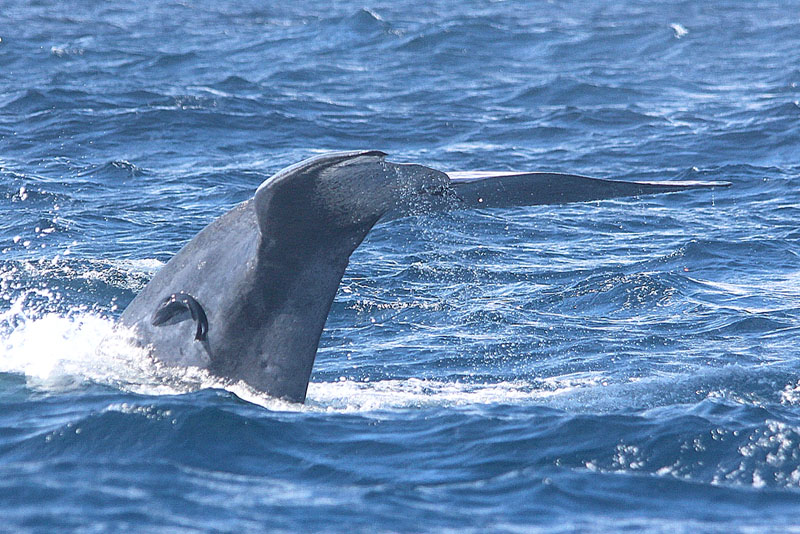
Population
Blue whales are rare and range over huge, remote areas of the worlds oceans, that and that many feeding and breeding grounds still remain unknown making accurate estimates of there exact population not really possible.
Sightings of Antarctic Blue Whales in Antarctic waters remain rare despite substantial survey efforts over many years. It is estimated that there is only a population of between 1700 and 2280 individuals, which is thought to represent less that 1% of the original population.
Little is known about the population size of the Pygmy Blue Whale.
Whaling had a catastrophic effect on Blue Whale numbers! It’s estimated that by 1973 only 360 Antarctic Blue Whales survived commercial whaling out of a population of 239,000. There is no comparable data for Pygmy Blue Whales and it is estimated by the IWC that 11,000 were illegally killed after whaling bans were introduced. Given how many whales were killed, the slow reproduction rate and the many other threats such as pollution and climate change the whales are facing any meaningful population recovery will take a long time with everything going very well.
Habitat
The habitat of the two Blue Whales subspecies found in Australian waters varies.
The Antarctic Blue Whales tends to remain deep in the Southern Ocean off Antarctica feeding and only migrate north to feed, breed or have their calves. Some will stay in Antarctic waters all year.
In comparison, the Pygmy Blue Whale habitat is far more diverse, expanding out from the Southern Ocean into the Indian Ocean and up to the tropical waters of Indonesia in the west and up past New Zealand and out into the South Pacific in the east.
Blue Whales seek out the rich waters of ocean upwellings to feed on the concentrations of prey. Upwellings are caused by a combination of ocean floor topography, currents and winds that draw nutrient-rich cold water upwards towards the ocean’s surface where the replace the often nutrient-depleted, surface water. The combination of rich nutrient filled waters and sunlight provided a bounty of food for phytoplankton to grow. This is often seen as a ‘bloom’ of cloudy green water on the oceans surface and is a vital food source for many animals from Krill to fish. These feed a whole range of larger animals including crustaceans (crabs and lobsters), fish, squid, seals and whales. Depending upon the conditions an upwelling ‘event’ may last anything from a few hours to several weeks. Thus their timing and intensity can vary from year to year.
The Bonney Upwelling – The Bonney Upwelling is part of the Great Southern Australian Coastal Upwelling System stretching from Portland in Victoria, past Robe and on to Kangaroo Island in South Australia. It is one of Australia’s natural marine wonders. Here in these rich waters between Cape Otway, Victoria, and Robe, South Australia Pygmy Blue Whales congregate to feast on the masses of prey in its rich waters.
Off the Bonney Coast west of Portland (hence the name) the combination of a narrow continental shelf and a series of submarine canyons are ideal to produce a powerful upwelling. All you need then is the wind coming from the right direction as it does during spring and summer each year. These spring and summer south easterlies drive ocean currents to the north west along the coast displacing the surface water. As the warm surface water is moved away it draws up the cold nutrient rich waters from deep below. These cold nutrient rich waters have travelled slowly across the floor of the Southern Ocean, up the west coast of Tasmania and into the Great Australian Bight where the combination of currents, ocean canyons on the edge of the continental shelf and winds force them to the surface. While the upwelling may extend across the entire continental shelf where waters are less than 200 metres deep it will only reach the surface in certain areas where the conditions are right, like they are off the Bonney Coast.
The whales will gather where the prey is most concentrated. These aggregation points are often found along narrow temperature fronts downstream of where the upwelling reaches the surface. The rich elevated levels of chlorophyll attracts swarms of the Krill. Krill tend to swarm on or near the surface so this is where the whales will feed too.
The Perth Canyon – The Leeuwin Current is a warm ocean current that flows down the western coast of Australia, around its south western tip and across the Great Australian Bight. As the current passes across the steep-sided Perth Canyon eddies cause both downwelling and compensating upwellings. The complete dynamics of this process are not completely understood but from November–May Krill swarm on the northern side of the canyon in the cold waters below the warm waters of the Leeuwin Current. This all happens at depths greater than 200 metres.
Geographe Bay – The whales use the shallow waters Geographe Bay as a rest stop on their migrations along the west coast. During October–December wales can be found in southern section of the bay adjacent to Cape Naturaliste. Whales can often be sighted within a few hundred meters of the Cape and in very shallow water (10–30 metres).
Antarctica – Sightings of Blue Whales in the remote and vast Southern Ocean are rare so distributed and preferred habitat in this region are not very well defined. What few observations that have been made tend to suggest that whales will be found in areas where prey concentrate along such as along the edges of decaying or open sea ice.
Breeding Grounds (Wintering Areas) – Blue Whales lack the thick blubber layers that Humpback and Southern Right Whales have which implies that they cannot fast during the winter season. So breeding grounds need to occur in areas that are also rich in prey. This theory is supported by the occurrence of Blue Whales in tropical upwellings in the eastern Pacific Ocean such as the Costa Rica Dome and the waters west of the Galapagos Islands.
During the winter months Blue Whales have been reported off the Indonesian archipelago and in the the waters of the south-west Pacific adjacent to the Solomon Islands.
Behaviours
Blue whales tend to be solitary often found alone or in pairs, although they can sometimes be found in small groups of two to four individuals. They will gather in larger numbers in feeding and breeding grounds.
Their vast, powerful and streamlined bodies allow them to cruise along effortlessly at around 5 to 7 km/h. When needed they can sustain high speed bursts of over 40 km/h.
Adults rarely if ever breach, although young whales can sometime be seen doing so. Breaches are usually at about a 45° angle with the whale landing on its stomachs or sides. Blue whale will often lift their tails out of the water when diving.
Blue Whales feed by ‘lunging’ into concentrations of their prey with mouths wide open allowing them to take massive mouthfuls of water (and prey). They then use their tongues like a ram to force the water out of their mouths through their baleen plates which separates the food from the water. Feeding frequently occurs on or near the surface but also at depth depending on where the prey is most concentrated.
Vocalisations – The Blue Whale are amongst the loudest animals on Earth with their powerful low-frequency calls. They emit a series of pulses, groans, and moans in the 10–30 Hz range. These calls vary between different regions and between the two subspecies. It is thought that with the right conditions these calls can be heard over 1,000 kilometres away. Given Blue Whales excellent hearing it is thought that these powerful vocalisations may not only be used to communicate, but o sonar-navigate.
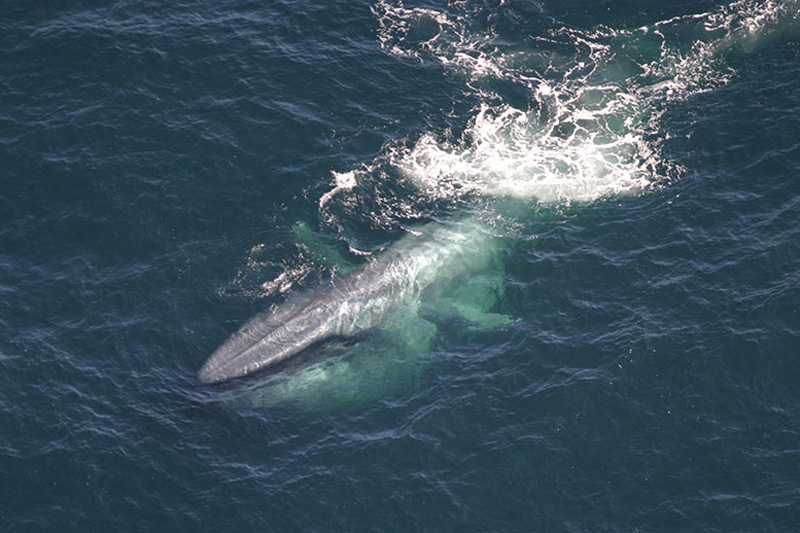
Feeding
Blue Whales feed mainly on Krill and are also known to feed on fish and squid.
Antartica – In Antarctic waters Blue Whales feed on Krill (Euphausia superba and E. crystallorophias) year round with a peak season over the summer months. The whales are thought to migrate into Antarctic waters in early summer and stay until autumn. Acoustic surveys have recorded their presence during the winter indicating that some whales many not migrate each year.
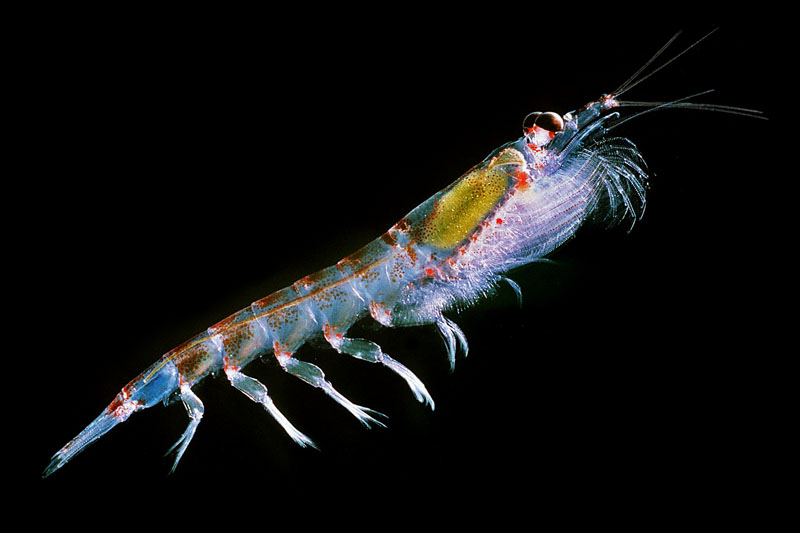
Australia – In Australian waters the best known feeding grounds are the Perth Canyon in Western Australia and the Bonney Upwelling off South Australia and Victoria.
Bonney Upwelling: During November to December Pygmy Blue Whales gather in the western area of the Bonney Upwelling system along the Eastern Great Australian Bight and next to Kangaroo Island canyons. The upwelling is active between November and May. Here the whales feed on Krill (Nyctiphanes australis). This species of Krill occurs along the south eastern coast of Australia from Kangaroo Island in South Australia in the west, around Tasmania an up the east coast to Sydney in New South Wales. Given this range there may be other yet undiscovered feeding areas along the coast. The whales mainly feed at or near the surface by lung feeding as well as at depth.
Perth Canyon: The main species of Krill (Euphausia recurva) the Blue Whales feed on is found between Shark Bay and Albany. In the Perth Canyon they are found at depth (200-500 metres) during the day and then migrating to the surface at night. Due to the depth of the prey the whales also dive to these depths to feed.
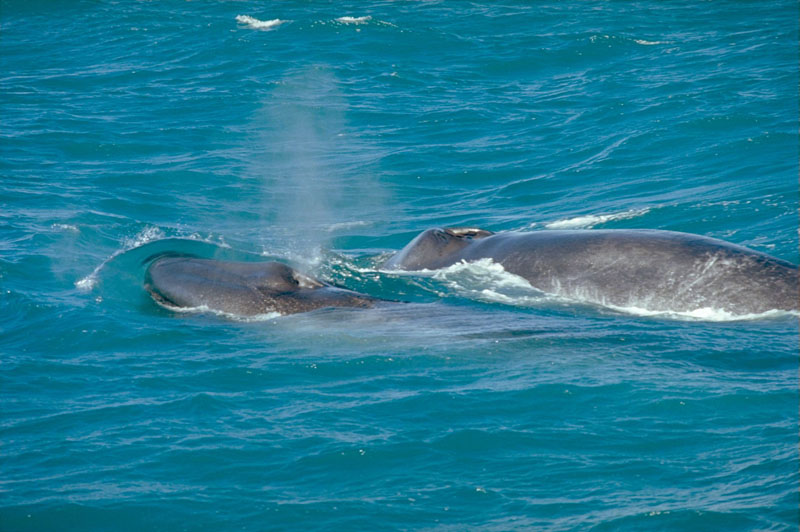
Life Cycle
Lots about the lives of Blue Whales is still unknown but thought to be like other whale species that we know more about.
Blue whales seem to exhibit no well-defined social structure other than the bond between mother-calf. They are generally solitary or found in small groups. How they mate is this unknown but it is thought that they may mate with multiple partners. When in the breading grounds a male will trail the female so he can keep other males away. Females breed every two to three years. Calves are born after a 10 to 11 month pregnancy and the calves are weaned at around 8 months. Blue whales become sexual maturity is reached at 7–10 years of age with their first reproduction after they are 11 years old. Females are around 23-24 metres in length when they become sexually mature, males around 22 metres. The lifespan is thought to be at least 80 years perhaps much longer.
Blue Whales breeding grounds are not well known but are thought to be in deep water near tropical island groups and in the vicinity of currents that provide rich feeding grounds. As Blue Whales have relatively thin blubber layers for their size it is thought that they are unable to fast during migrations.
The natural mortality rates of Blue Whales are unknown but as with other whale species the calves are vulnerable to attacks from Killer Whales and possibly larger shark species. They may also be affected by infections, diseases and parasites but the effects of these is unknown.
Hybridisation – In recent years there have been several example of Blue Whale – Fin Whale hybrids caught in illegal whaling. Each showed that the animal had parents from the different species.
Threats
Like all marine mammals Ble Whales have a number of natural and man made threats. Tragically the biggest treat to them is mankind and our activities such as whaling, pollution and climate change.
Natural – Given they’re immense size adult Southern Blue have few natural predators, although they have been known to be attacked and sometimes killed by Killer Whales. So the young and sick whales may be attached by Killer Whales and sharks.
Man Made – Pollution, climate change, acoustic disturbance, ship strikes, entanglement and over-harvesting of food sources (such as Krill stocks), whaling and habitat destruction.
Surface feeding could make them vulnerable to entanglement and ship strike. When the whales are strongly focused on feeding they appear completely oblivious to nearby ships. They also show a strong startle response when making contact with lobster pot lines which could cause entanglements.
Over recent years many seismic surveys have been conducted in the Southern Ocean where the whales go to feed. How and to what extent this acoustic pollution degrades the whales habitat is not yet fully understood but has the potential to significantly impact them by stopping the whales accessing important feeding areas.
Sadly Blue Whales were heavily impacted by commercial whaling. Initially their size and speed made them almost impossible to hunt. It wasn’t until the invention of the exploding harpoon gun, along with steam/ diesel-powered ships that the whales significantly targeted. Between 1866 and 1978 more than 380,000 blue whales were killed, mostly in Antarctic waters. In 1931 alone over 29,000 Blue Whales were killed
A BIG Love for Dr Peter Gill – the Blue Whale Study
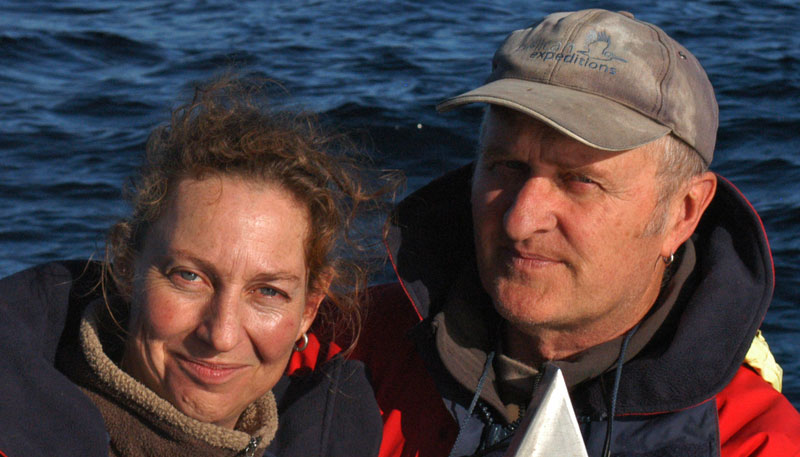
My great thanks to Dr Peter Gill, Senior Research Scientist with the Blue Whale Study for his generous advice and guidance in creating this page.
Dr Peter Gill studies the largest animals that have ever lived – the Blue Whale. Here Peter shares how he became involved in this study and some of the amazing things he’s learnt about them.
Peter Gill first became involved in humpback whale research on the NSW coast in 1983. This led to research using small sailing vessels to follow humpback whale migrations into tropical and Antarctic waters.
In the late 1990s he came across a survey report describing the sighting of an unusual number of blue whales near Portland, Victoria. At this time blue whales were rarely sighted around the Australian coast. Sailing there with a group of friends in early 1998 he found blue whales feeding there.
He also learnt about the Bonney Upwelling, a unique oceanographic phenomenon which brings massive amounts of nutrients onto the continental shelf off western Victoria and south-east South Australia, feeding abundant krill which in turn are food for blue whales and a diversity of other marine fauna.
Peter moved to western Victoria in 2000 and has since lived near Portland, the home port for the Blue Whale Study and its ecological research into blue whales and the Bonney Upwelling. He shares this work with his colleagues Margie Morrice and Rebecca Pirzl.
To learn more about more about Blue Whales and Peter, Margie and Rebecca’s work please see their website by following this link.
Blue Whale Study
References/Sources
Australian Department of the Environment, Canberra
NSW Department of the Environment
QLD Department of the Environment
The Blue Whale Study
Whales, Dolphins and Porpoises by Mark Carwardine
Whales, Dolphins & Seals: A Field Guide to the Marine Mammals of the World by Hadoram Shirihai and Brett Jarrett
Copyright 2020 David Jenkins – Whale Spotter
